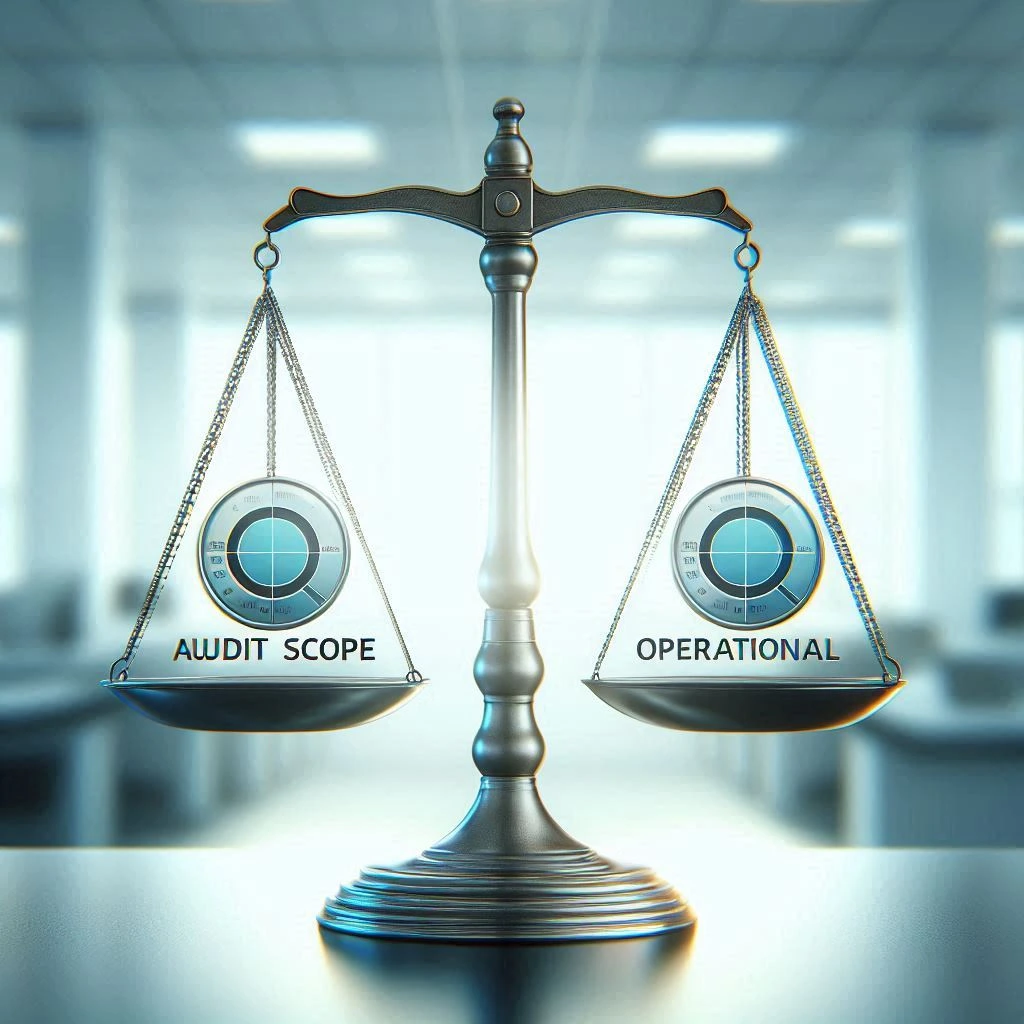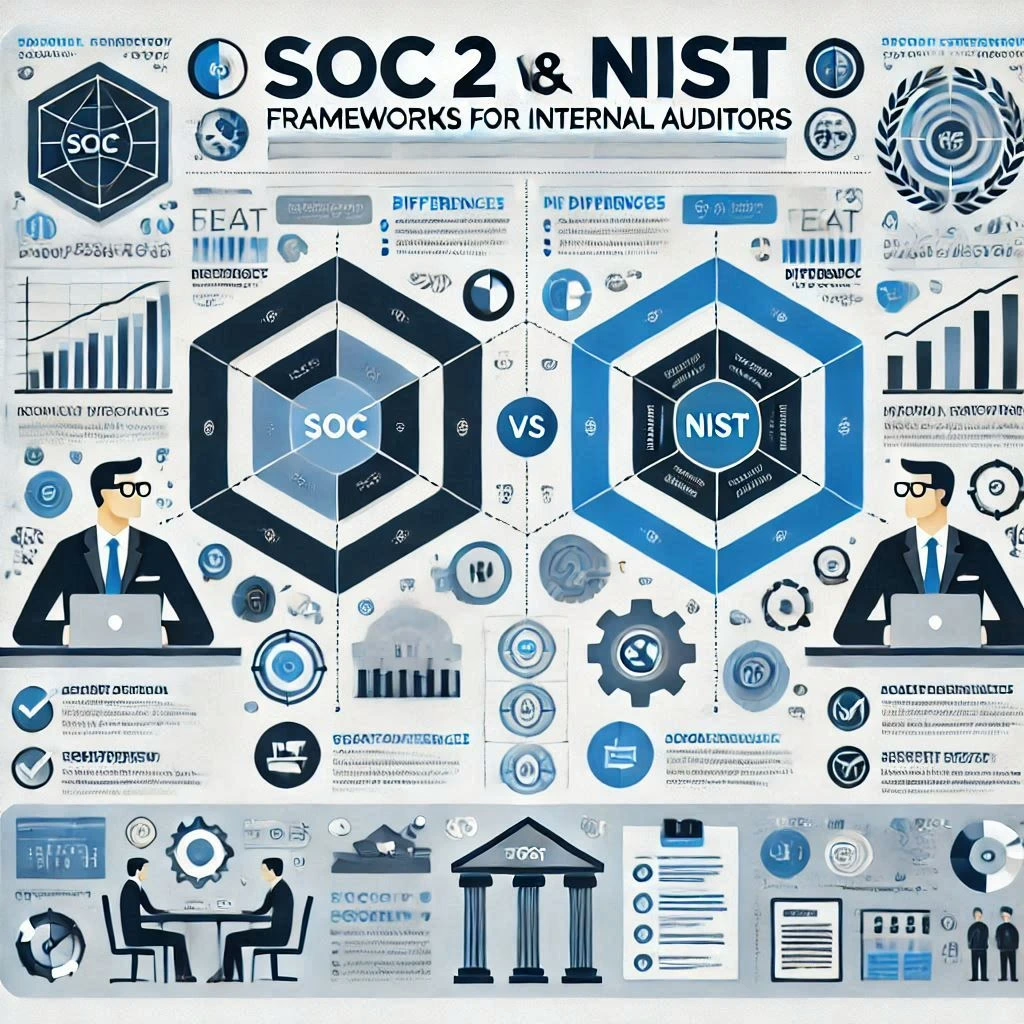Introduction
In the realm of internal auditing, the concept of audit scope plays a pivotal role in shaping the effectiveness and efficiency of the audit process. Audit scope refers to the boundaries and objectives defined for an audit engagement, encompassing the areas to be examined, the depth of the examination, and the specific objectives that the audit aims to achieve. A well-defined audit scope is essential as it not only ensures that the audit is thorough and objective but also aligns with the organization’s governance, risk management, and compliance efforts. By clearly delineating what will be reviewed, organizations can avoid unnecessary work, identify potential risks, and facilitate clear communication throughout the audit process [1][13].
On the other hand, operational efficiency is a critical aspect for organizations striving to optimize their internal processes and achieve their strategic goals. It involves the ability to deliver products or services in the most cost-effective manner while maintaining high quality. Operational efficiency is increasingly relevant in today’s competitive landscape, where organizations must maximize resource utilization and minimize waste to remain viable and successful [4][5].
The relationship between audit scope and operational efficiency is intricate and significant. A balanced approach to defining audit scope can enhance operational efficiency by ensuring that audits focus on high-risk areas and critical processes that directly impact the organization’s performance. Conversely, an overly broad or poorly defined audit scope can lead to inefficiencies, as auditors may expend resources on areas that do not contribute meaningfully to the organization’s objectives. Therefore, the thesis of this discussion posits that finding the right balance between audit scope and operational efficiency is crucial for conducting effective internal audits that not only assess compliance and controls but also drive organizational improvement and value [10][15].
In the following sections, we will delve deeper into how internal auditors can strategically define audit scope to enhance operational efficiency, ultimately contributing to the overall success of the organization.
Understanding Audit Scope
In the realm of internal auditing, the concept of audit scope is pivotal to ensuring that audits are effective and aligned with organizational goals. A well-defined audit scope not only enhances operational efficiency but also ensures that resources are utilized effectively. Below is a comprehensive overview of what audit scope entails, including its components, determination process, and significance.
Components of Audit Scope
- Objectives: The primary objectives of an audit serve as the foundation for its scope. These objectives should be specific, measurable, achievable, relevant, and time-bound (SMART) to guide the audit process effectively. Common objectives may include assessing compliance with regulations, evaluating the effectiveness of internal controls, and verifying the accuracy of financial statements [1][10].
- Boundaries: The boundaries of an audit define the extent and limits of the audit engagement. This includes specifying which areas of the organization will be audited, the time frame for the audit, and the specific processes or departments involved. Clearly delineating these boundaries helps prevent scope creep and ensures that the audit remains focused on its objectives [14].
- Resources: Resources encompass the personnel, tools, and time allocated to the audit. Adequate resources are essential for conducting a thorough audit, as they determine the depth and breadth of the audit procedures. The allocation of resources should align with the assessed risks and the complexity of the processes being audited [12].
Determining Audit Scope
The determination of audit scope is a critical step that involves a thorough risk assessment and consideration of organizational needs. Key factors influencing this process include:
- Risk Assessment: A comprehensive risk assessment identifies areas of potential non-compliance or inefficiency within the organization. High-risk areas warrant a broader scope to ensure that all identified risks are adequately addressed. This assessment serves as a compass, guiding auditors in tailoring the scope to the unique contours of the organization [13][15].
- Organizational Needs: Understanding the specific needs and objectives of the organization is crucial in defining the audit scope. This includes considering the strategic goals of the organization, regulatory requirements, and stakeholder expectations. By aligning the audit scope with these needs, auditors can provide valuable insights that enhance operational efficiency [11].
Importance of Clearly Defined Audit Scope
A clearly defined audit scope is essential for several reasons:
- Audit Effectiveness: A well-articulated scope ensures that the audit is focused and relevant, leading to more meaningful findings and recommendations. It helps auditors concentrate on critical areas that impact the organization’s performance and compliance [14].
- Resource Optimization: By clearly defining the scope, organizations can avoid unnecessary work and allocate resources more efficiently. This optimization is particularly important in today’s fast-paced business environment, where time and resources are often limited [14].
- Facilitating Communication: A defined audit scope fosters clear communication among stakeholders, including management, auditors, and the board. It sets expectations and provides a framework for discussing audit findings and recommendations, ultimately contributing to better decision-making [14].
Understanding audit scope is fundamental for internal auditors and CFOs aiming to enhance operational efficiency. By focusing on the components of audit scope, determining it based on risk assessment and organizational needs, and recognizing its importance, organizations can conduct effective audits that drive performance and compliance.
The Importance of Operational Efficiency
Operational efficiency is a critical concept that refers to the ability of an organization to deliver products or services in the most cost-effective manner while maintaining high quality. It is often measured through various key indicators, including:
- Cost Reduction: This involves minimizing expenses without compromising quality. Organizations strive to reduce costs through streamlined processes, better resource management, and waste elimination.
- Time Savings: Efficient operations lead to quicker turnaround times for products and services. This can enhance customer satisfaction and improve market competitiveness.
- Resource Utilization: Effective use of resources, including human capital, technology, and materials, is essential for maximizing output and minimizing waste.
Operational efficiency significantly contributes to overall business success by enabling organizations to:
- Enhance Profitability: By reducing costs and improving productivity, companies can increase their profit margins. Efficient operations allow for competitive pricing strategies that can attract more customers.
- Improve Customer Satisfaction: Faster service delivery and higher quality products lead to better customer experiences, fostering loyalty and repeat business.
- Adapt to Market Changes: Organizations that operate efficiently can respond more swiftly to market demands and changes, ensuring they remain relevant and competitive.
Internal audits play a vital role in identifying inefficiencies within an organization. They provide an independent assessment of operational processes, helping to uncover areas where improvements can be made. The audit process involves:
- Evaluating Processes: Internal auditors assess existing workflows and procedures to identify bottlenecks or redundancies that hinder efficiency.
- Recommending Improvements: Based on their findings, auditors can suggest actionable recommendations that align with the organization’s goals, ultimately enhancing operational efficiency.
- Ensuring Compliance: By ensuring that operations comply with relevant regulations and standards, internal audits help mitigate risks that could lead to inefficiencies or financial losses.
The relationship between audit scope and operational efficiency is crucial for organizational performance. A well-defined audit scope allows internal auditors to focus on key areas that impact efficiency, ensuring that their recommendations lead to meaningful improvements. By prioritizing operational efficiency through effective internal audits, organizations can achieve sustainable growth and success.
The Interplay Between Audit Scope and Operational Efficiency
In the realm of internal auditing, the scope of an audit plays a pivotal role in determining not only compliance and risk management but also the overall operational efficiency of an organization. Striking the right balance between a focused audit scope and the need for comprehensive oversight is essential for CFOs and internal auditors aiming to enhance organizational performance. Below, we explore the relationship between audit scope and operational efficiency, highlighting potential tensions and providing insights into achieving an optimal balance.
Narrow Audit Scope: The Risk of Overlooking Inefficiencies
A narrowly defined audit scope can lead to significant operational inefficiencies being overlooked. When auditors concentrate solely on specific areas, they may miss critical processes that contribute to inefficiencies elsewhere in the organization. For instance, if an audit focuses exclusively on financial compliance without considering operational workflows, it may fail to identify bottlenecks or redundancies that hinder productivity. This oversight can result in missed opportunities for improvement and cost savings, ultimately affecting the organization’s bottom line.
- Example: A manufacturing company that limited its audit to financial controls might overlook inefficiencies in its supply chain processes, leading to increased costs and delays in production. By not assessing the broader operational context, the audit fails to provide a comprehensive view of the organization’s performance.
Overly Broad Audit Scope: Resource Strain and Inefficiencies
Conversely, an overly broad audit scope can lead to resource strain and operational inefficiencies. When auditors attempt to cover too many areas, they may dilute their focus, resulting in a lack of depth in their analysis. This can lead to inefficient use of resources, as auditors may spend excessive time on low-risk areas while neglecting high-risk processes that require more attention.
- Example: An organization that conducts a blanket audit across all departments without prioritizing high-risk areas may find itself overwhelmed. The audit team could become bogged down in minutiae, leading to delays in reporting and actionable insights. This not only strains resources but also diminishes the overall effectiveness of the audit process.
The interplay between audit scope and operational efficiency is a delicate balance that, when managed effectively, can lead to significant organizational benefits.
Strategies for Balancing Audit Scope and Operational Efficiency
Achieving a balance between audit scope and operational efficiency is crucial for internal auditors and CFOs. A well-defined audit scope not only enhances the effectiveness of the audit process but also contributes to the overall operational efficiency of the organization. Here are some actionable strategies to help internal auditors and CFOs find this balance:
- Adopt a Risk-Based Approach: Internal auditors should prioritize a risk-based approach when defining the audit scope. This involves identifying and assessing risks that could impact the organization’s objectives and aligning the audit focus with these risks. By concentrating on high-risk areas, auditors can ensure that their efforts are directed towards aspects that significantly affect organizational goals, thereby enhancing operational efficiency [1][3].
- Engage Stakeholders: Effective stakeholder engagement is essential in determining the audit scope. By involving key stakeholders, including management and operational teams, auditors can gain insights into relevant areas that require attention. This collaborative approach ensures that the audit scope encompasses critical operational processes and risks, leading to more relevant and impactful audit outcomes [6][10].
- Implement Continuous Improvement Practices: Establishing feedback loops and continuous improvement practices can significantly refine audit processes. Internal auditors should regularly solicit feedback from stakeholders on the audit process and outcomes. This feedback can be used to adjust the audit scope and methodologies, ensuring that they remain aligned with the evolving needs of the organization. Continuous improvement not only enhances the audit function but also contributes to operational efficiency by streamlining processes and reducing redundancies [2][11].
- Utilize Technology and Data Analytics: Leveraging technology and data analytics can enhance the efficiency of the audit process. By utilizing advanced tools, auditors can analyze large volumes of data quickly, identify trends, and focus on areas that require deeper investigation. This technological integration allows for a more dynamic audit scope that can adapt to changing operational landscapes, ultimately driving better outcomes for the organization [2][5].
- Balance Strategic and Operational Needs: It is vital to strike a balance between strategic and operational auditing needs. While strategic audits focus on long-term risks and opportunities, operational audits address day-to-day challenges. By ensuring that both aspects are considered in the audit scope, internal auditors can provide comprehensive insights that support both immediate operational efficiency and long-term strategic goals [4].
By implementing these strategies, internal auditors and CFOs can effectively balance audit scope with operational efficiency, leading to enhanced organizational performance and value creation.
Tools and Technologies to Enhance Efficiency
In the realm of internal auditing, the balance between a comprehensive audit scope and operational efficiency is crucial. As organizations strive to optimize their audit processes, leveraging the right tools and technologies can significantly enhance efficiency while ensuring that the audit scope remains effective. Here are some key points to consider:
- Data Analytics: The integration of data analytics into the audit process plays a pivotal role in identifying areas for efficiency. By analyzing large volumes of data, auditors can pinpoint trends, anomalies, and risk areas that require attention. This analytical approach not only streamlines the audit process but also allows for a more focused scope, ensuring that resources are allocated to the most critical areas of concern. Utilizing data analytics can lead to more informed decision-making and a deeper understanding of operational efficiencies within the organization [1].
- Software Solutions for Automation: The advent of various software solutions has revolutionized the way audits are conducted. Automation tools can handle routine tasks such as data collection, documentation, and preliminary analysis, which traditionally consumed significant time and resources. By automating these processes, internal auditors can redirect their efforts towards more complex evaluations that require human judgment and expertise. This shift not only enhances operational efficiency but also ensures that the audit scope is maintained at a high standard, focusing on areas that truly matter [2].
- Visualization Tools: Effective communication of audit findings is essential for driving action and understanding within an organization. Visualization tools can transform complex data into easily digestible formats, such as charts and graphs, which enhance the clarity of audit reports. By presenting findings visually, auditors can facilitate better discussions with stakeholders, ensuring that the implications of the audit are understood and acted upon. This not only improves the overall effectiveness of the audit but also reinforces the importance of maintaining a well-defined audit scope that aligns with organizational goals.
The relationship between audit scope and operational efficiency can be significantly improved through the strategic use of data analytics, automation software, and visualization tools. By embracing these technologies, CFOs and internal auditors can enhance their audit processes, ensuring that they remain both comprehensive and efficient.
Conclusion
In the realm of internal audit, achieving a harmonious balance between audit scope and operational efficiency is paramount. A well-defined audit scope not only ensures compliance and risk mitigation but also enhances the overall effectiveness of the audit process. By focusing on key risks and controls, auditors can provide valuable insights that contribute to strengthening internal controls and mitigating risks effectively, which ultimately supports the organization’s operational goals [9].
CFOs and internal auditors are encouraged to continually assess and adjust their audit scope in response to evolving business environments and stakeholder expectations. This proactive approach allows organizations to remain agile and responsive to changes, ensuring that the audit process remains relevant and adds value to the organization [5].
Moreover, fostering an ongoing dialogue about best practices in audit scope and operational efficiency is essential. Engaging in discussions with key stakeholders can lead to a deeper understanding of expectations and the identification of areas for improvement within the audit function [4][11]. By prioritizing communication and collaboration, organizations can enhance their internal audit processes, ultimately driving greater operational efficiency and effectiveness.
In conclusion, the relationship between audit scope and operational efficiency is a dynamic one that requires continuous attention and adaptation. By embracing this challenge, CFOs and internal auditors can significantly contribute to their organizations’ success and resilience in an ever-changing landscape.
Find out more about Shaun Stoltz https://www.shaunstoltz.com/about/
This post was written by an AI and reviewed/edited by a human.



